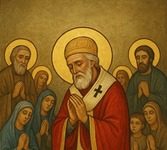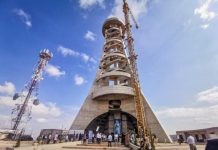History of the Maronites
Courtesy of the Maronite Heritage Site
On the mountains of Lebanon, in this mystical land, in these deep valleys, among these white mountains, in the land of honey and milk, in the nation of the Cedar and the Alphabet, in the Phoenician land, there the Maronite Church, the smallest of all the churches, has grown like a mustard seed and became a tree, so that several churches and denominations have come to be sheltered in its branches. The history of the Maronites was sealed by persecution and martyrdom for the sake of Faith, Freedom, and Independence.
Who are the Maronites? What is the Maronite Church?
The Maronites are those Christians who gathered around a monastery called Bet Moroon or the House of Maron built in 452 on the Orontes River, after the Council of Chalcedon and the request of Pope Leo. Those Christians who defended their faith in Jesus Christ, human and divine, were called Maronites after a hermit priest, St. Maron, who was a great saint in that region of Syria.
St. Maron
St. Maron lived on the mountains of Cyrrhus, near Antioch, in the 4th century AD, in the open air. God bestowed on him the gift of healing, which made his fame spread in the entire region. St. Maron died around the year 410 AD. His disciples continued his mission. Abraham the hermit, the apostle of Lebanon, converted the Phoenician inhabitants of the mountains of Lebanon. Jebbet Bsharre and Mnaytra adopted Christianity. The Phoenician pagans became Maronite Christians.
Bet Moroon
In 451, the fathers of the Church held a meeting at the Council of Chalcedon. They clarified the teaching of the Church concerning the person of Jesus Christ. They proclaimed that Jesus Christ was both human and divine. The Maronites strongly defended the Council of Chalcedon, which made the Monophysites their bitter enemies. Pope Leo requested to build a monastery for the disciples of St. Maron on the Orontes River. The monastery was called Bet Moroon. The conflict between the Maronites and the Monophysites led to a strong persecution that left 350 martyrs and many refugees in 517. The Maronites informed Pope Hormizdes about their struggle for the sake of faith and their martyrs. The pope of Rome sent them a letter to strengthen the Maronites describing the Maronite martyrs as soldiers of Jesus Christ and members of his Living Body.
St. John Maron
Around 685, the Maronites appointed a Patriarch, St. John Maron, who became the first Patriarch on the Maronite Church, which made the Byzantine Emperor furious about that. The appointing of the Patriarch was a very important event in the history of the Maronites, which led to another persecution that left 500 martyrs. The monastery of Bet Moroon was damaged. Many Maronites left their lands in Syria and joined their brethren in the mountains of Lebanon. In the valleys of Lebanon, the Maronite Church began to grow.
The Mountains of Lebanon
In 936, the monastery of Bet Moroon and other Maronite monasteries were completely destroyed in Syria. That persecution was aimed at Christians. They were persecuted for the sake of Jesus Christ. The Maronites and their Patriarch had to take a very difficult decision: to leave the rich plains of Syria and take the mountains of Lebanon as a refuge. The Aramaic/ Syriac Maronites joined the Phoenician Maronites and the Mardaites in Lebanon. Protected by the mountains of Lebanon, the Maronites and their Patriarch were organizing their Church away from persecution.
The Crusades
For 350 years, the Maronites have been isolated in the valleys and mountains of Lebanon until the beginning of the crusades. When the Crusaders invaded the East, they were surprised when they found out about the existence of the Maronites. The Pope of Rome himself was astonished. During the Crusades Period, the Maronites succeeded in building relationships with France (especially after the visit of St Louis, King of France) and the Pope of Rome.
The Mamlooks
At the end of the crusades and after the defeat of the Crusaders, the Maronites were attacked by the Mamlooks. Between 1268 and 1283, persecution began with the Mamlooks, who attacked the strongholds of the Maronites sowing destruction in Ehden, Bsharre, Hadath El-Jibbet, Meifook, and other villages. They captured the Maronite Patriarch and sent him to his death. Between 1291 and 1305, the Mamlooks destroyed Kesrwan and the Maronites were forbidden to enter it. The Maronites had to learn how to survive and to protect their freedom. But in 1357, they became divided against themselves: The Maronites of Byblos-Batroun against those of Bsharre. Consequently, the Mamlooks invaded Byblos and Batroun, destroying their villages, and burning their Patriarch alive in 1367. Many people escaped to Cyprus. The Maronites lost their freedom. Because of the many disasters that happened in the world in that period of time (13th- 16th century), especially in the Middle East, the Pope of Rome, Leo X described the Maronite Church as a rose among thorns, an impregnable rock in the sea, unshaken by the waves and fury of the thundering tempest.
The Ottomans & Independence
In 1516, the Ottomans defeated the Mamlooks. The Maronites were granted protection by France. They expanded in Lebanon and mixed with other minorities. The Maronites built churches, founded religious orders, formed schools, and cultivated arid lands. The valleys and the mountains were filled with monks and hermits. Many families converted to Christianity, joined the Maronite Church, and participated in the table of the Lord. But between 1845 and 1860, hatred was incited by the Ottomans, who worked so hard to break the Maronites’ spirit of independence. Dozens of villages, churches, and monasteries were completely destroyed. Thousands were martyred or displaced, and many immigrated. The persecution returned between 1914 and 1918, when the Ottomans blocked the roads to the mountains of Lebanon causing a human disaster. Tens of thousands of people died of famine and diseases, and thousands immigrated. After the First World War, Lebanon was liberated from the Ottomans. France, Lebanon’s compassionate mother, entered the mountains of Lebanon. The Maronite Patriarch left for Paris. He arrived on October 25th, 1919. He requested the recognition of Lebanon as an independent country. On September 1st, 1920, General Gouraud proclaimed the State of Greater Lebanon in the presence of the Maronite Patriarch. In 1943, Lebanon won its independence.
Persecution & Diaspora
Peace did not last too long. Between 1975 and 1990, Lebanon experienced a destructive war. Tens of thousands died in wars, and thousands immigrated. The Pope of Rome supported the Maronites through his prayers. The Maronites defended their country with great courage, but in 1990, they divided against themselves, fighting each other. Consequently, their enemies invaded them, bombarding their cities and villages, sending their leaders into exile, and putting others in jail. The Maronites lost their independence and hundreds of thousands left the mountains of Lebanon and immigrated. Freedom became threatened. But God did not abandon his people.
He consoled the Maronites, giving them three saints: St. Sharbel, St. Rafqa, and St. Nimatullah Hardini. In 1997, the Pope of Rome, John Paul II visited Lebanon to give hope to the Lebanese people and particularly to the Maronites. He said, “Lebanon is more than a country, it is a message”. Due to the severe persecution of the Church in Lebanon (especially the Maronite Church), many were scattered throughout the world, which made the Church grow outside Lebanon. That’s how the Early Church grew outside Jerusalem. The Maronite Church became international. She does not only include Phoenician Maronites, Aramaic/Syriac Maronites, Mardaites, Arab Maronites, but also American Maronites, European Maronites, Brazilian Maronites, Australian Maronites, etc…
Since 2000, the Maronite Patriarch, Nasrallah Boutros Sfeir, has been launching appeals for the restoration of Lebanon’s freedom and sovereignty. On September 2, 2004, France and the USA sought a new UN resolution asking Lebanon’s neighbors to withdraw their soldiers and respect Lebanon’s sovereignty.
http://www.maronite-heritage.com/History.php
http://www.maronite-heritage.com/LNE.php?page=index




















